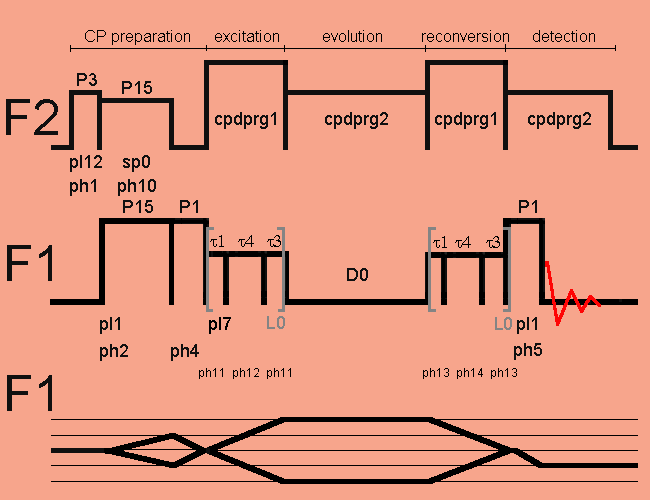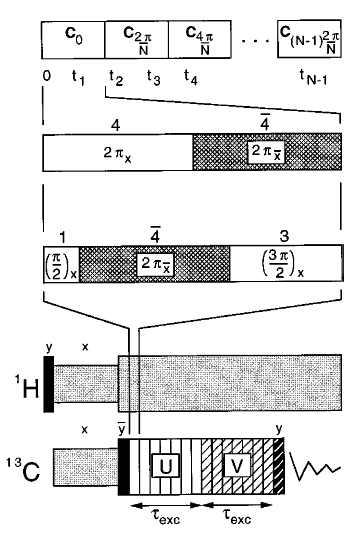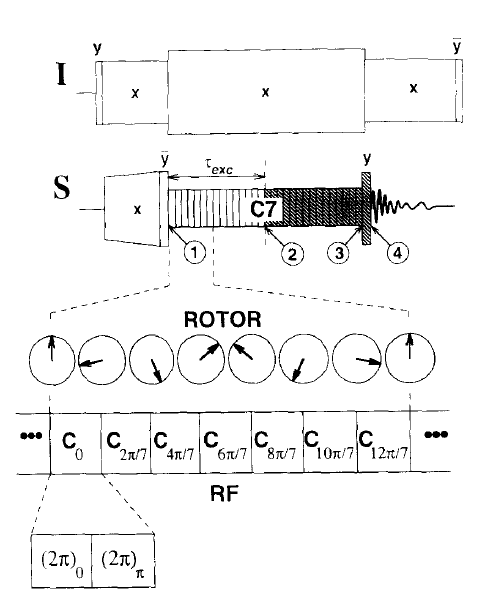
PC7CP2d: 2D cross-polarization/2Q excitation POST_C7 pulse program for TopSpin2.1

Since non-phase cycling is applied to the PC7 excitation pulse, four-phase cycling is applied to the detection pulse P1 for selecting the 0Q -> -1Q coherence order jump, and four-phase cycling is applied to the PC7 reconversion pulse for filtering DQ coherences.
Avoid cross-polarization during POST C7 excitation and reconversion.
;pc7cp2d (TopSpin 2.1) ;2D SQ-DQ correlation experiment with POST_C7 sequence and cross polarization ;Hohwy, M. Jakobsen, H.J. Eden, M. Levitt, M.H., Nielsen, N.C., ;J. Chem. Phys. 108, 2686-2694 (1998) ;revised 09/09/03 JOS modified by HF 14.5.07 ;Avance III version ;parameters: ;d1 : recycle delay ;d0 : incremented delay (2D) [1 usec] ;p1 : detection pulse at pl1 ;p3 : 1H excitation pulse @ PL12 ;p5 : FSLG 2pi pulse set by lgcalc.incl ;p15 : HH contact pulse ;pl1 : f1 power level ;pl2 : =120dB, not used ;pl7 : for POST C7 recoupling sequence, B1=7*cnst31 in Hz ;pl12 : for 1H excitation and decoupling ;pl13 : for LG decoupling cpdprg1 = cwlg or cw13 or tppm13 ;pcpd2 : decoupling pulse f2 @ PL12, pcpd = 2*P3-0.2us used by TPPM and SPINAL ;sp0 : proton power level during contact ;spnam0 : for CP on 1H e.g. ramp.64 ;cpdprg1: decoupling f2 during C7, e.g. cw (or cwlg) or tppm ;cpdprg2: decoupling f2, e.g. tppm15, SPINAL64 ;cnst20: LG-RF field as adjusted, in Hz used to calculate cnst22 ; and cnst23 +and - LG frequency ;cnst21: =0 frequency reset on resonance (set by lgclac.incl) ;cnst22: +LG frequency offset calc. by lgcalc.incl ;cnst23: -LG frequency offset calc. by lgcalc.incl ;cnst24: offset for 1H evol. during FSLG ;cnst31: spinning speed ;l0 : number of composite C7 cycles for DQ excitation ; and DQ reconversion (multiple of 7) ;l3 : number of rotorperiods for t1 increment ;in0 : =l3*(1s/cnst31), t1 increment ;FnMode: undefined ;mc2 : STATES-TPPI ;ns : 32*n ;WDW : F1 QSINE 3, F2 QSINE 2 or EM ;use "xau xfshear rotate" to shift spectrum suitably along f1 ;$COMMENT=SQ-DQ experiment with post-C7 sequence, cp for excitation ;$CLASS=Solids ;$DIM=2D ;$TYPE=cross polarisation ;$SUBTYPE=homonuclear correlation ;$OWNER=Bruker define loopcounter count ;for STATES-TPPI procedure "count=td1/2" ;and STATES cos/sin procedure define pulse tau1 "tau1=((0.25s/cnst31)/7)" ; 90° pulse define pulse tau4 "tau4=((1s/cnst31)/7)" ;360° pulse define pulse tau3 "tau3=((0.75s/cnst31)/7)" ;270° pulse "d31=1/cnst31" "in0=l3*d31" "inf1=l3*d31" ;cnst11 : to adjust t=0 for acquisition, if digmod = baseopt "acqt0=1u*cnst11" #include <lgcalc.incl> ;calculates cnst22 from cnst20, RF field at pl13 #include <rot_prot.incl> "d0=1u" ze 1 d31 2 d1 do:f2 ;recycle delay, decoupler off #include <p15_prot.incl> ;make sure p15 does not exceed 10 msec ;let supervisor change this pulseprogram if ;more is needed #ifndef lacq ;disable protection file for long acquisition change decoupling power !!! ;or you risk probe damage ;if you set the label lacq (ZGOPTNS -Dlacq), the protection is disabled #include <aq_prot.incl> ;allows max. 50 msec acquisition time, supervisor ;may change to max. 1s at less than 5 % duty cycle ;and reduced decoupling field 1m rpp11 ;reset the phase ph11 pointer to the first element 1m rpp12 ;reset the phase ph12 pointer to the first element 1m rpp13 ;reset the phase ph13 pointer to the first element 1m rpp14 ;reset the phase ph14 pointer to the first element 1u fq=cnst22:f2 ;show LG frequencies 1u fq=cnst23:f2 1u fq=cnst21:f2 (p3 pl12 ph1):f2 ;proton 90° pulse (p15 pl1 ph2):f1 (p15:sp0 ph10):f2 ;contact pulse with square or ;ramp shape ramp.100 on F2 (p1 pl1 ph4):f1 ;90° pulse putting magnetization back to z-axis ;for PC7 double-quantum excitation 3 (tau1 pl7 ph11 ipp13 ipp14):f1 (1u cpds1):f2 ;c7 excitation, 1 loop = 2*Tr/7, ;increment reconversion pulse phase ph13 and ph14 pointers ;pl13=120 for masr > 15 kHz ;F2 decoupling cw (or cwlg) or tppm (tau4 ph12 ipp12):f1 ;increment phase ph12 pointer (tau3 ph11 ipp11):f1 ;increment phase ph11 pointer ;to the next phase in the lists lo to 3 times l0 ;l0 DQ excitation block = DQ reconversion block 4 d0 cpds2:f2 ;double-quantum evolution time, ;F2 decoupling tppm15, SPINAL64 5 (tau1 ph13):f1 (1u cpds1):f2 ;c7 reconversion, 1 loop = 2*Tr/7, ;F2 decoupling cw (or cwlg) or tppm (tau4 ph14 ipp14):f1 ;increment phase ph14 pointer (tau3 ph13 ipp13):f1 ;increment phase ph13 pointer ;to the next phase in the lists lo to 5 times l0 (p1 pl1 ph5):f1 (1u cpds2):f2 ;F2 decoupling cpdprg2 spinal64, ;@ pl12, cnst21=on resonance, ;pcpd=2*p3-0.2us ;detection pulse gosc ph31 ;gosc does not loop to 1 ;start ADC with ph31 signal routing 1m do:f2 ;decoupling off ;DQ filtering (four phase cycling): ;1m ip13 ;increments all phases of ph13 by 90° ;1m ip14 ;increments all phases of ph14 by 90° 1m ip13*16384 ;increments all phases of ph13 by 90° 1m ip14*16384 ;increments all phases of ph14 by 90° lo to 1 times ns ;next scan 100m wr #0 if #0 zd ;save data ;1m ip11 ;increments all phases of ph11 by 45°, ;90° phase for DQ coherence ;1m ip12 ;increments all phases of ph12 by 45°, ;90° phase for DQ coherence 1m ip11*8192 ;increments all phases of ph11 by 45°, ;90° phase for DQ coherence 1m ip12*8192 ;increments all phases of ph12 by 45°, ;90° phase for DQ coherence lo to 1 times 2 ;t1 quadrature detection 1m id0 ;1m rp11 ;reset all phases of ph11, ph12, ph13, and ph14 ;1m rp12 ;to their original values, i.e. to the values they ;1m rp13 ;had before the first ip11, ip12, ip13, and ip14 ;1m rp14 ;in case of STATES remove semicolon at beginning of the 4 lines lo to 1 times count ;count = td1/2 HaltAcqu, 1m exit ph1= 1 1 1 1 3 3 3 3 ph2= 0 ph4= 3 3 3 3 1 1 1 1 ph5= 0 0 0 0 0 0 0 0 2 2 2 2 2 2 2 2 1 1 1 1 1 1 1 1 3 3 3 3 3 3 3 3 ph10=0 ;ph11 = (float,45.0) 0.00 51.43 102.86 154.29 205.71 257.14 308.57 ;ph12 = (float,45.0) 180.00 231.43 282.86 334.29 385.71 437.14 488.57 ;ph13 = (float,90.0) 90.00 141.43 192.86 244.29 295.71 347.14 398.57 ;ph14 = (float,90.0) 270.00 321.43 372.86 424.29 475.71 527.14 578.57 ph11=(65536) 0 9362 18725 28087 37449 46811 56174 ph12=(65536) 32768 42130 51493 60855 4681 14043 23406 ph13=(65536) 16384 25746 35109 44471 53833 63195 7022 ph14=(65536) 49152 58514 2341 11703 21065 30427 39790 ph31= 0 2 0 2 0 2 0 2 2 0 2 0 2 0 2 0 1 3 1 3 1 3 1 3 3 1 3 1 3 1 3 1

Definition of PC7 excitation pulse.

Definition of C7 excitation pulse.